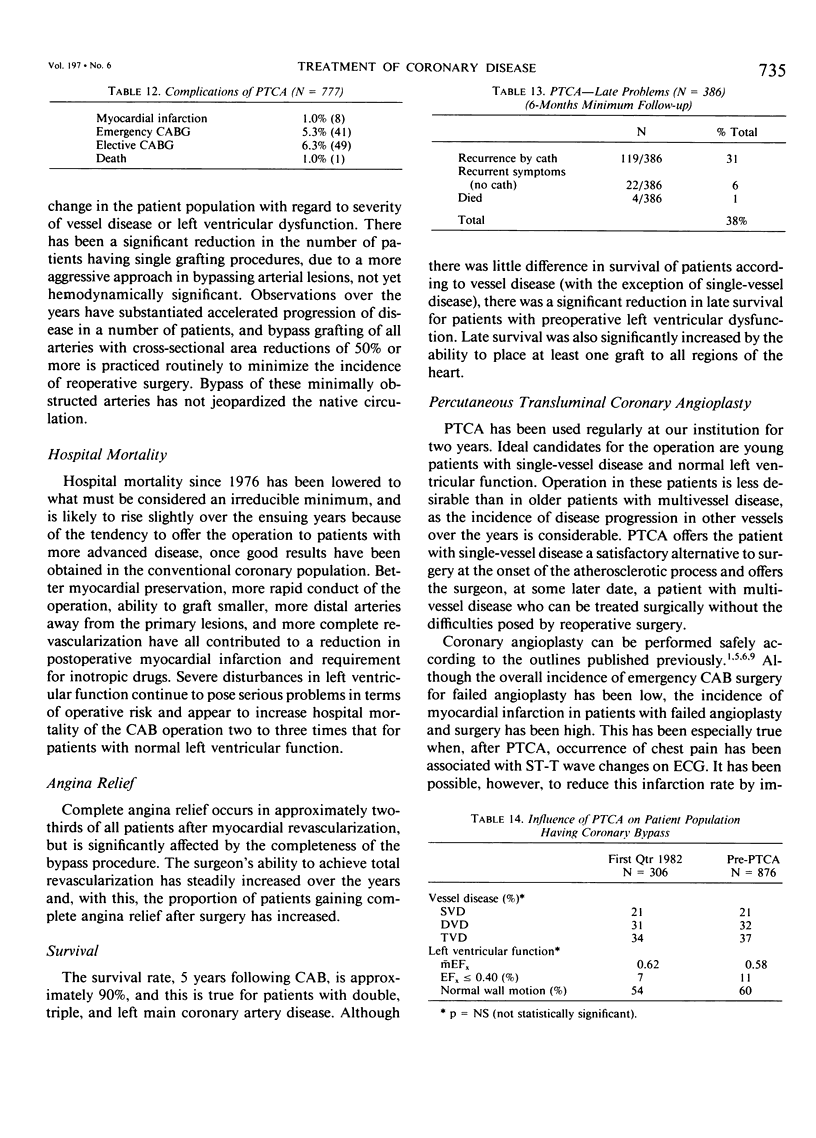Abstract
Selection and treatment of patients with ischemic heart disease is presently undergoing an evolutionary trend. Percutaneous transluminal coronary angioplasty (PTCA) has been recommended as the initial procedure for many patients with coronary artery disease (CAD), thus possibly redefining candidates for coronary bypass surgery (CABS). Between October 1980 and June 1982, 777 patients having PTCA and 2068 patients having CABS were analyzed for differences in clinical presentation, complications, and early outcome. Patients having CABS were significantly older, had a higher incidence of hypertension (46% vs. 32%), more multivessel disease (80% vs. 12%), and poorer left ventricular function (nl. wall motion = 88% vs. 52%). The incidence of myocardial infarction in patients after PTCA was 1.0% (8/777). Emergency CAB was required in 5.3% of patients following PTCA. There were no deaths following the angioplasty procedure and 25 deaths in 2068 patients having CABS (hospital mortality rate = 1.2%). Since 1973, there has been a progressive decline in hospital mortality rate (now, less than 1%), postoperative infarction (now, 3%), requirement for inotropic drugs (now, 5%) and frequency of IABP (less than 1%). Increasing ability to achieve complete revascularization now means improved survival and freedom from angina with CAB surgery. PTCA and CAB are both procedures that may be used effectively for selected patients, depending on clinical presentation, extent of CAD, and left ventricular function (LVF). Careful patient selection affords the opportunity for use of PTCA in patients with single-vessel disease (SVD) and good LVF and CABS in patients with multivessel disease, regardless of LVF. Symptomatic patients with SVD and total vessel occlusion are not candidates for PTCA. Our data demonstrate that both PTCA and CABS may be accomplished with very low perioperative complications and hospital mortality.
Full text
PDF








Selected References
These references are in PubMed. This may not be the complete list of references from this article.
- Ford W. B., Wholey M. H., Zikria E. A., Miller W. H., Samadani S. R., Koimattur A. G., Sullivan M. E. Percutaneous transluminal angioplasty in the management of occlusive disease involving the coronary arteries and saphenous vein bypass grafts: preliminary results. J Thorac Cardiovasc Surg. 1980 Jan;79(1):1–11. [PubMed] [Google Scholar]
- Grüntzig A. R., Senning A., Siegenthaler W. E. Nonoperative dilatation of coronary-artery stenosis: percutaneous transluminal coronary angioplasty. N Engl J Med. 1979 Jul 12;301(2):61–68. doi: 10.1056/NEJM197907123010201. [DOI] [PubMed] [Google Scholar]
- Jones E. L. Coronary artery bypass grafting: simplification and refinement of surgical technique. Ann Thorac Surg. 1980 Jul;30(1):84–87. doi: 10.1016/s0003-4975(10)61210-6. [DOI] [PubMed] [Google Scholar]
- Jones E. L., Craver J. M., Grüntzig A. R., King S. B., 3rd, Douglas J. S., Bone D. K., Guyton R. G., Hatcher C. R., Jr Percutaneous transluminal coronary angioplasty: role of the surgeon. Ann Thorac Surg. 1982 Nov;34(5):492–503. doi: 10.1016/s0003-4975(10)62994-3. [DOI] [PubMed] [Google Scholar]
- Jones E. L., Craver J. M., Kaplan J. A., King S. B., 3rd, Douglas J. S., Morgan E. A., Hatcher C. R., Jr Criteria for operability and reduction of surgical mortality in patients with severe left ventricular ischemia and dysfunction. Ann Thorac Surg. 1978 May;25(5):413–424. doi: 10.1016/s0003-4975(10)63577-1. [DOI] [PubMed] [Google Scholar]
- Jones W. B., Riley C. P., Reeves T. J., Sheffield L. T. Natural history of coronary artery disease. Bull N Y Acad Med. 1972 Oct;48(9):1109–1125. [PMC free article] [PubMed] [Google Scholar]
- Loop F. D., Cosgrove D. M., Lytle B. W., Thurer R. L., Simpfendorfer C., Taylor P. C., Proudfit W. L. An 11 year evolution of coronary arterial surgery (1968-1978). Ann Surg. 1979 Oct;190(4):444–455. doi: 10.1097/00000658-197910000-00004. [DOI] [PMC free article] [PubMed] [Google Scholar]
- Mundth E. D., Austen W. G. Surgical measures for coronary heart disease (third of three parts). N Engl J Med. 1975 Jul 17;293(3):124–130. doi: 10.1056/NEJM197507172930306. [DOI] [PubMed] [Google Scholar]
- Murphy D. A., Craver J. M., Jones E. L., Gruentzig A. R., King S. B., 3rd, Hatcher C. R., Jr Surgical revascularization following unsuccessful percutaneous transluminal coronary angioplasty. J Thorac Cardiovasc Surg. 1982 Sep;84(3):342–348. [PubMed] [Google Scholar]
- Reeves T. J., Oberman A., Jones W. B., Sheffield L. T. Natural history of angina pectoris. Am J Cardiol. 1974 Mar;33(3):423–430. doi: 10.1016/0002-9149(74)90327-0. [DOI] [PubMed] [Google Scholar]


